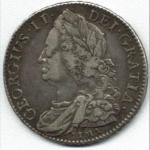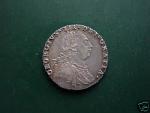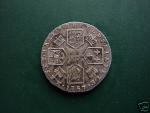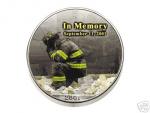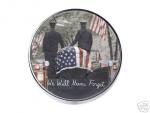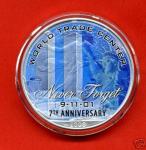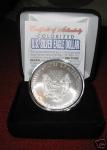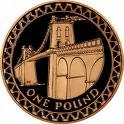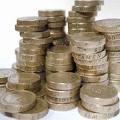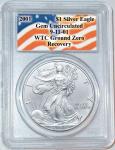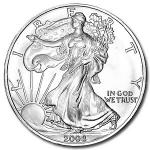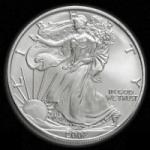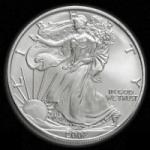-
Posts
3,517 -
Joined
-
Last visited
-
Days Won
27
Content Type
Profiles
Forums
Blogs
Gallery
Events
Store
Everything posted by bigjarofwasps
-

King`s shilling, anyone....?
bigjarofwasps replied to bigjarofwasps's topic in Coins & Commemorative Medallions
The King's shilling - for many years a soldier's daily pay, before stoppages - was the shilling given to recruits of the British army and the Royal Navy of the 18th and 19th centuries. The expression "to take the King's shilling" meant that a man agreed to serve as a soldier or sailor. Recruiters of the time used all sorts of tricks, most involving strong drink, to press the shilling on unsuspecting victims. The man did not formally become a soldier until attested before a Justice of the Peace, and could still escape his fate by paying his recruiter "smart money" before attestation. In the 1840's this amounted to ?1 (twenty shillings), a sum most recruits were unlikely to have at hand. One trick supposedly employed by press gangs was to slip the shilling into a drink. If the prospective soldier drank the drink to the bottom (so that the shilling was now visible), it was taken as a sign that they had accepted Impressment. It is believed that glass bottomed Tankards became popular as a result of this practice. This, however, is a myth. Recruiters were subject to fines if they used trickery in order to recruit civilians. Also, men who signed up to serve in the military were given a four day 'cooling off' period, during which they were permitted to change their minds. -
The King's Shilling Oh my love has left me wi' bairnies twa And that's the last o' him I ever saw He's joined the army and he marched awa' He took the shillin' He took the shillin' and he marched awa' Come laddies come, hear the cannons roar Tak' the King's shilling an' we're off tae war Oh he looked sae prood and sae gallant then Wi' his kilt and sporran an' his musket gun And the ladies kissed them as they marched awa' And they sailed awa' boys They sailed awa', boys, by the Broomielaw The pipes they played as they marched along And the men they sang oot a battle song "March on, march on," cried our Captain gay And for King and country For King and country we will fight this day The battle echoed tae the sound o' guns And bayonets flashed in the morning sun The drums did beat and the cannons roared And the shillin' didn't seem The shillin' didn't seem much worth no more Some lost the battle their bodies fell Cut doon by bayonets and musket ball And many o' these brave young men Would never fight for Would never fight for their King again Oh my love has left me wi' bairnies twa And that's the last o' him I ever saw He's joined the army and he marched awa' He took the shillin' He took the shillin' and he marched awa'
-

2008 Silver Eagle
bigjarofwasps replied to bigjarofwasps's topic in Coins & Commemorative Medallions
No shortage here I`m afraid, in fact 2008 looks like being a bumper crop!!!!! Jan - Sep: 12,902,500 -

World Trade Centre
bigjarofwasps replied to bigjarofwasps's topic in Coins & Commemorative Medallions
Found this link, which I thought might also be of interest........... http://merrickmint.stores.yahoo.net/ -

World Trade Centre
bigjarofwasps replied to bigjarofwasps's topic in Coins & Commemorative Medallions
-

World Trade Centre
bigjarofwasps replied to bigjarofwasps's topic in Coins & Commemorative Medallions
Okey so this eagle wasn`t recovered, from the WTC, however, I think its attractive none the less...... -

30 million in fake Pound Coins!
bigjarofwasps replied to bigjarofwasps's topic in Coins & Commemorative Medallions
Thats the very first thing I thought of when I heard this tale of woe. There not as uncommon as you might think. Certainly when the latest ones where released people thought they were fakes. Seems to be a pretty hard way to make crime pay? I suppose if you where going to use them in cigerette machines or something maybe? But even so -

30 million in fake Pound Coins!
bigjarofwasps replied to bigjarofwasps's topic in Coins & Commemorative Medallions
Video link........... http://news.bbc.co.uk/1/hi/uk/7628137.stm The number of fake ?1 coins in circulation has doubled in the last five years and now stands at more than 30 million, the BBC has learned. This means one in every 50 pound coins in circulation is counterfeit. Experts believe the fakes are being produced by organised criminal gangs using specialist machinery. The Royal Mint said it was illegal to make or use counterfeited coins and said people must hand them in if they thought they had one. Although relatively easy to detect, their sheer number creates problems for shopkeepers, taxi drivers and other small traders who deal in cash for many of their transactions. According to figures obtained by the BBC from the Royal Mint, random sampling tests carried out earlier this year showed that approximately 2% of pound coins are fake. Confidence in coins The Royal Mint described the counterfeiting rate as "a comparatively low incidence of counterfeit coins by international monetary standards." However, other experts disagree. Robert Matthews, was the Queen's Assay master until he retired to become a coin consultant four years ago. He said confidence in coins collapsed in other countries when forgery rates reached similar levels. He said: "In 2004, people started refusing to take the South African 5 Rand coin, due to concerns about the number of counterfeits, and eventually the coin had to be redesigned and re-circulated. "Independent surveys showed the number of counterfeits to be 2% - the same as we've got here - and I'm worried that if we're not careful the same thing will happen to the pound coin." Since its introduction in 1983, there have always been attempts to forge pound coins, but the numbers were relatively small. The last time forgery figures were released by the Royal Mint, in 2003, the number of fakes were estimated to be 1%. This suggests the number of counterfeit coins has doubled in the last five years. The euro is a far more "secure" coin when compared to the pound. In 2006 it was estimated of 13 billion circulating coins (50c, ?1 and ?2), around 10 million were fakes, which works out at less than 0.1% of the total. Mr Matthews said: "The EU has been openly directing that Euro coins have to be authenticated after withdrawal and before reissue without creating public panic. I know of no public moves of this nature in the UK." He said he was worried that in Britain, dealing with the fakes was falling between Royal Mint, HM Treasury, the banks and the police, with no one taking direct responsibility. "And, at current detection rates, it'll take 120 years for the counterfeit coins that are circulating right now to be withdrawn," he added. The Royal Mint said in a statement: "We track the counterfeit rate through regular surveys in the spring and autumn every year. The survey consists of taking a random sample of coins from across the country, and subjecting them to individual analytical inspection. "It is a criminal offence to make or use counterfeited coins. Any member of the public who suspects they have a counterfeited coin should not attempt to spend it." -
'30m fake pound coins in circulation' The number of fake ?1 coins in circulation appears to have doubled in the last five years, it was reported today. The results of a sampling test by the Royal Mint, obtained by the BBC, show that up to 2 per cent of all the pound coins in circulation may be fake - approximately 30 million coins. The last time sampling test results were released was in 2003 when the number of forged pounds coins was estimated to be 1 per cent. The BBC said it means that one in every 50 pound coins in circulation is counterfeit. Robert Matthews, formerly the Queen's Assay Master until he retired to become a coin consultant four years ago, said confidence in coins collapsed in other countries when forgery rates reached similar levels. He told the broadcaster: "In 2004, people started refusing to take the South African 5 Rand coin due to concerns about the number of counterfeits, and eventually the coin had to be redesigned and re-circulated. "Independent surveys showed the number of counterfeits to be 2 per cent - the same as we've got here - and I'm worried that if we're not careful the same thing will happen to the pound coin." In a statement, the Royal Mint said: "We track the counterfeit rate through regular surveys in the spring and autumn every year. The survey consists of taking a random sample of coins from across the country, and subjecting them to individual analytical inspection. "It is a criminal offence to make or use counterfeited coins. Any member of the public who suspects they have a counterfeited coin should not attempt to spend it." The BBC says that experts test for forgeries by studying lettering and the cross on the edge of the coin, whether the Queen's head is orientated the same way as the image on the reverse, and whether the marking is centred on the face. How do you spot a fake pound coin? The number of fake ?1 coins in circulation now stands at more than 30 million, according to the Royal Mint. How do you know if you've been given one? That ?1 coin in your pocket could be worthless. The number of fake pound coins in circulation has doubled in the past five years and one in every 50 is now counterfeit. It's illegal to make or use counterfeited coins and the Royal Mint says people must hand them in if they think they have one. But how can you tell? It all depends on the quality of the counterfeit, but key signs include a poorly defined ribbed edge, the wrong typeface and an indistinct design or bust of the Queen. A fake can also be slightly different in colour. "Current fakes are what we call 'soapy' in the coin business," says Garry Day, who works for a leading coin dealer, AH Baldwin. "This means the marking and detail on them, like the queen's head, are blurred and not very distinct." Poor workmanship Another way to identify a fake is to check the alignment of the coin. Hold it so the Queen's head is upright and facing you - when you turn the coin over, the pattern on the reverse should also be upright. Fakes can often be at an angle. The Royal Mint's online design portfolio can also be used to easily identify what's genuine and what's not. Since they were introduced in 1983, the design on the reverse of the coins has changed every year. Often the year and the design do not correspond on a fake. Also, the Latin motto on the edge of the coin should also correspond to the right year. A simple test at any automated vending machine can also identify a suspect coin. A lot of counterfeit coins are rejected, often leaving you grappling to find another coin in your purse or pocket. But ultimately, how easy it is to identify a fake comes down its quality. The good news is the fakes are getting worse, according to some experts. "Quality is definitely dropping and fakes are now quite obvious, even to the untrained eye," says Mr Day, who has been studying the problem. "The workmanship isn't what it used to be and most are pretty easy to spot. People just need to know what they are looking for."
-

NATO medals.....
bigjarofwasps replied to bigjarofwasps's topic in Great Britain: Orders, Gallantry, Campaign Medals
I believe that the ACSM, is for holders of the GSM, who have done 1000 days service, with Ireland being the longest running British campaign that the GSM was awarded for it stands to reason that this is the most notable one. I`m sure you`ve all seen the Irish Regiment on parade with GSM & ACSM + 3 or 4 bars!!!! I also believe that in addition to the GSM any service where by the Queen authorises an medal, service also counts towards the ACSM, so by that if you`ve done a 1000 days in Iraq you would qualify, Afghanistan looks like it`ll be set to be a long haul, so I would imgaine that in years to come you`ll see guys with the OSM & ACSM..... -

NATO medals.....
bigjarofwasps replied to bigjarofwasps's topic in Great Britain: Orders, Gallantry, Campaign Medals
Ed the ACSM, a classic example I`d forgotten about that one. -

NATO medals.....
bigjarofwasps replied to bigjarofwasps's topic in Great Britain: Orders, Gallantry, Campaign Medals
Cheers Ed. You could also always argue the case of the Bosnia UN/NATO tour that the guys got two gongs for the same tour?!!...(1995 or there abouts) Am I reading this right, that the US only have one UN medal ribbon, so once you`ve got it, you don`t get any more? `Policy`!!! Since when has one been better than two? -
The NATO medal family seems to be growing.... http://en.wikipedia.org/wiki/NATO_Medal http://www.worldmedals.co.uk/NATO/nato.htm But just out of interest can anyone tell me why British troops are not allowed to wear the NATO medal for Afghanistan? Are there any other NATO medals, that British troops can`t wear? Why is that US troops were the NATO medals but not the bars?
-
Hi Guys, Found this which I thought might be of interest. Gold Sovereigns get everywhere!!! http://www.wtc911coins.com/topics/wtc-english-coins/
-

World Trade Centre
bigjarofwasps replied to bigjarofwasps's topic in Coins & Commemorative Medallions
I was surfing the net & came across this website that I thought might be of interest to anyone who collects coins recovered from the World Trade Centre? http://www.wtc911coins.com/ -

2008 Silver Eagle
bigjarofwasps replied to bigjarofwasps's topic in Coins & Commemorative Medallions
Marc and there in lies the game, it appears that if the trueth be known there is in fact no shortage, in fact 2008 stands to be a bumper year for eagles if production carries on at its current rate. -

2008 Silver Eagle
bigjarofwasps replied to bigjarofwasps's topic in Coins & Commemorative Medallions
May's silver American Eagle bullion total of 1,516,000 has been replaced by the numbers from the first week of June. The 425,000 figure is a respectable weekly number. Unfortunately, the Mint's silver blank suppliers cut by half the number they can supply weekly to the Mint. Sooner or later, this drop will show up in the numbers and it is probably likely that the June monthly total will be significantly fewer. The Mint points out that so far this year, the 10.07 silver one-ounce bullion Eagle's struck already exceeds last year's total for the whole year , which was 9.03 million pieces. http://en.wikipedia.org/wiki/American_Silver_Eagle -

2008 Silver Eagle
bigjarofwasps replied to bigjarofwasps's topic in Coins & Commemorative Medallions
The ongoing supply shortage of 2008 silver American Eagles got the attention of the Silver Institute, when its executive director, Michael DiRienzo, wrote a letter to Mint Director Ed Moy asking that steps be taken to increase the number being struck. "It's clear that the Mint misjudged the strength of the current silver market, and we are encouraging the Mint to take immediate steps to increase its production of these popular investment coins and plan accordingly for the balance of 2008 and for 2009," DiRienzo wrote. The Mint issued a statement in response: "Since the introduction of the 2008 American Eagle Silver Bullion Coin Program, the United States Mint has issued a record number of coins (about 9.65 million), as demand for them has increased exponentially. That number is almost as high as the United States Mint's production for the entire year of 2007 (about 9.8 million). "By law, the United States Mint's American Eagle silver bullion coins must meet exacting specifications and must be composed of newly mined silver acquired from domestic sources. The United States Mint will continue to make every effort to increase its acquisition of silver bullion blanks that meet these specifications and requirements to address continuing high demand in the silver bullion coin market." The Silver Institute notes that over 165 million silver American Eagles have been produced since they were introduced in 1986. Headquartered in Washington, D.C., the Silver Institute is a nonprofit international silver industry association founded in 1971 -

2008 Silver Eagle
bigjarofwasps replied to bigjarofwasps's topic in Coins & Commemorative Medallions
The 2008 Silver Eagle Transitional Variety The 2008-W Silver Eagle has been found to have a fascinating variety type! The experts at Numismatic Guaranty Corporation, (usually referred to as "NGC,") have reported that an unknown quantity of U.S. Silver Eagles have been struck using a reverse die meant for the 2007 Silver Eagle. The Silver Eagles in question have all been minted at the West Point Mint, and bear the W Mint mark. These Silver Eagles are not the ones that are sold as bullion coins by dealers; the W mark is only applied to coins which are struck with a "satin finish" and sold as "Uncirculated" via the U.S. Mint's Web site (although dealers do sell them, too, on the secondary market.) The diagnostics to determine whether or not your Silver Eagle has the 2007 reverse type are pretty simple to detect. The easiest difference to find is in the shape of the U in UNITED. On the 2007 dies, this letter has a straight-line U without a "spur." On the 2008 reverse dies, the letter U does have a "spur", which looks like the little added stroke usually seen on the lower-case U, which appears on the bottom right side of the letter. -

2008 Silver Eagle
bigjarofwasps replied to bigjarofwasps's topic in Coins & Commemorative Medallions
Monday, June 9, 2008 2008 Silver Eagle Shortage Saga Continues For much of 2008, there has been an ongoing shortage of 2008 American Silver Eagles. Demand for the coins has been intense, leading the Mint to briefly suspend distribution and ultimately ration the quantities supplied to authorized dealers. This post will take you through the major developments of the past few weeks... A little over two weeks ago, the problem went mainstream when the Wall Street Journal covered the story: The government rationed food during World War II and gasoline in the 1970s. Now, it's imposing quotas on another precious commodity: 2008 dollar coins known as silver eagles. Following the exposure generated by the article, Michael DiRenzo, the Executive Director of the Silver Institute, wrote a letter to US Mint Director Edmund Moy, urging him to stabilize the program and requesting a meeting. From the letter: Reports that the U.S. Mint is limiting the amount of coins its authorized buyers are allowed to purchase concerns the Institute, primarily because at the end of the supply chain awaits a customer, who is being inconvenienced and possibly shut out of the purchase of these coins. We strongly believe there are immediate remedies at your disposal to increase the production and delivery of blanks to the Mint for production that would provide the coins in sufficient supply to the authorized dealers and ultimately to the customers. We further believe the Mint should be looking at methods to streamline the current process and offer safeguards through planning and a concerted shift in current strategy for the second half of 2008, and beyond. The US Mint responded to the letter with a brief statement explaining the "exponential" demand for the coins along with indication that the Mint would attempt to increase its silver acquisition efforts to meet demand. From the statement: By law, the United States Mint's American Eagle silver bullion coins must meet exacting specifications and must be composed of newly mined silver acquired from domestic sources. The United States Mint will continue to make every effort to increase its acquisition of silver bullion blanks that meet these specifications and requirements to address continuing high demand in the silver bullion coin market. During the same week, US Citizen Bix Weir wrote an open letter to US Secretary of the Treasury Hank Paulson and US Mint Director Edmund Moy. The letter claimed that the US Mint's rationing of Silver Eagle coins was illegal and demanded that the rationing end immediately. The letter cited US law law which stipulates that Silver Eagles must be minted and issued in "quantities sufficient to meet public demand." From the letter: The law is clear that the silver coins must be supplied to the US public in "quantities sufficient to meet public demand" EVEN IF it means the US Mint drives up the price of silver bullion on the open market in order to obtain the silver needed to produce the US Silver Eagles. That rise in price should, theoretically, decrease the current voracious demand for US Silver Eagles and allow for the true price discovery of silver bullion. That's how our freely traded markets are supposed to function in order to determine the ?fair market value? of any asset. So far, I have not seen any response from Hank Paulson, Edmund Moy, or the US Mint regarding this letter or its claims. At the end of last week, the US Mint sent a memorandum to authorized purchasers of American Silver Eagles. The Mint is expecting that their next incoming shipment of silver blanks will be less than half the amount shipped the previous week. From the letter: The quantities [silver blank vendors] will ship to us during the week of June 9 are expected to be less than half the quantities they shipped to us during the week of June 2. Our vendors, however, expect to be able to make incremental increases in supplies each week thereafter. In the mean time, the significant reduction in the number of blanks they supply to us will, of course, directly affect the quantity of coins we can make available for allocation to our Authorized Purchasers. This latest development does not seem particularly encouraging. It appears that despite the Mint's efforts to increase acquisition of silver for the program, the supply available to them is decreasing. Will these problems persist and if so, what will be the result? I think we will definitely see further outcry from individuals and interested organizations along with some additional mainstream news reporting. There might be more scrutiny over the Mint's silver acquisition process which seems to be at the root of the problem. Investors and coin collectors looking to invest in silver may re-visit old methods such as junk silver or silver bars. Alternately, other government issued silver bullion coins such as the Canadian Silver Maple Leaf may start to see an increase in popularity. -

2008 Silver Eagle
bigjarofwasps replied to bigjarofwasps's topic in Coins & Commemorative Medallions
-

2008 Silver Eagle
bigjarofwasps replied to bigjarofwasps's topic in Coins & Commemorative Medallions
Have just been surfing Ebay, trying to answer just that question. The best `buy it now` price I`ve found is ?13.99, but I suppose you might get lucky if you where to put a bid on one, and get it cheap? But thats Ebay for you! Only time will tell whether they`ve been a good investiment or not. But given the current trend with silver prices, etc, with a bit of luck they`ll be another year along the same lines as the 1996 coin. :jumping:



